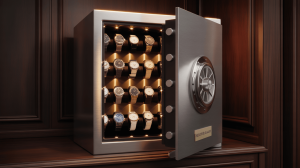Finding the perfect way to protect jewelry, documents, and automatic watches can feel overwhelming. A home winder safe combines vault-grade security with precision watch winding. This single unit locks away precious items and keeps your timepieces accurately wound. No more searching for keys, no more dead watches, and no more messy jewelry boxes. Every morning becomes simpler. Let’s explore how a home winder safe offers both peace of mind and everyday convenience.
1. What Is a Home Winder Safe?
A home winder safe is a secure cabinet designed to store valuables and wind automatic watches. It has thick steel walls and a reinforced door to resist forced entry. Inside are rotating modules that simulate wrist movements for your automatics. Padded drawers or compartments keep jewelry organized and protected. Instead of separate safe and winder devices, you get a unified solution. This integration saves space and streamlines routines, allowing you to access everything in one place.
2. Why Combine Security and Winding?
Combining security with watch winding eliminates the need for multiple devices. A traditional safe locks away valuables but leaves automatic watches idle, requiring manual winding and resetting. A standalone winder keeps watches accurate but offers no security for other items. A home winder safe merges both functions. You secure jewelry, documents, and electronics while ensuring watches stay wound. This design adds convenience and reduces clutter, making it ideal for anyone who values both protection and precision.
3. Key Security Features
A home winder safe uses 12–14 gauge steel walls to deter intruders. Multi-point locking bolts secure the door from several angles. Many models meet UL RSC burglary standards, resisting pry bars, drills, and impact tools. Fireboard insulation and intumescent gaskets meet UL 72 Class 350 fire ratings. This means internal temperatures stay below 350°F for at least 30 minutes. Hidden hinges and reinforced frames prevent tampering. Biometric or electronic locks allow personalized access. A mechanical override key ensures you never lose entry. Bolt-down kits let you anchor the safe to floor joists or wall studs for added stability.
| Security Element | Specification | Benefit |
|---|---|---|
| Steel Wall Thickness | 12–14 gauge | High resistance to forced entry |
| Locking Mechanism | Multi-point bolts | Secures door at multiple points |
| Burglary Certification | UL RSC or ETL Burglary | Verified resistance to tools and attacks |
| Fire Rating | UL 72 Class 350 | Protects contents up to 350°F for 30 min |
4. Watch Winding Mechanisms Explained
Automatic watches rely on rotor motion to keep mainsprings tensioned. Built-in winding modules simulate wrist movements. You can program turns-per-day (TPD) settings from 650 to 2,000. Directional controls allow clockwise, counterclockwise, or bi-directional rotation. Pause intervals prevent over-winding and stress on delicate components. Precision Japanese or Swiss motors run under 25 dB, ensuring near-silent operation. The motors rest on rubber-damped mounts to reduce vibration. Over time, this careful winding preserves movement accuracy and lengthens service intervals.
5. Protecting Jewelry and Other Valuables
Inside the safe, velvet-lined drawers keep rings, earrings, and bracelets separate. Padded trays hold necklaces without tangling. Some safes include hidden compartments for cash, passports, and important documents. Soft suede or fabric linings prevent scratches on precious metals and gemstones. Each item stays organized and easy to locate. A unified safe reduces the risk of losing or misplacing valuables spread across multiple locations. Everything remains locked behind a solid steel door until you need it.
6. Climate and Humidity Control
Humidity can damage leather watch straps and tarnish silver or gold jewelry. Many home winder safes include passive desiccant chambers to absorb excess moisture. Some add active dehumidifiers with digital hygrometers for precise humidity regulation. IP54-rated seals on the door block dust and moisture from entering. Maintaining a stable 40–50% relative humidity protects pearls, leather, and metal against corrosion and cracking. Controlling the internal environment reduces cleaning and repair costs over time.
| Climate Feature | Description | Benefit |
|---|---|---|
| Desiccant Chambers | Passive moisture absorption | Low-maintenance humidity control |
| Active Dehumidifier | Automated moisture removal | Keeps RH at 40–50% |
| IP54 Seals | Dust and splash barrier | Protects valuables from environmental damage |
7. Interior Organization and Layout
A well-designed safe offers modular compartments that adapt to your collection. Removable foam inserts allow precise spacing for watches and jewelry. Ring rolls hold bands upright, preventing scratches. Earring posts keep pairs together. Necklace hooks suspend chains without tangling. Deep velvet-lined drawers hold larger pieces like cuff bracelets or bulky chains. The watch winding trays sit above these drawers, ensuring you access both types of valuables with ease. This layout maximizes space and keeps everything visible and organized.
8. Smart Connectivity and Alerts
Modern home winder safes integrate Bluetooth or Wi-Fi modules for real-time monitoring. You receive tamper alerts, door-open notifications, and low-battery warnings on your smartphone. A dedicated app allows remote lock/unlock, winding schedule adjustments, and access-log reviews. Enterprise-grade encryption secures these data transmissions. Smart alerts keep you informed whether you’re home or traveling. Remote oversight adds an extra layer of peace of mind for your most valuable possessions.
9. Power Supply and Backup Solutions
These safes use a dual-power system to ensure continuous operation. The primary AC adapter provides constant power. A rechargeable lithium-ion battery pack serves as backup during outages. Low-battery LED indicators and app notifications alert you before power depletion. If electronics fail, a concealed mechanical override key or combination dial ensures manual access. This layered approach guarantees you can always open the safe and retains watch winding functions even when electricity is unavailable.
| Power Source | Backup Method | Notes |
|---|---|---|
| AC Adapter | — | Primary, continuous operation |
| Rechargeable Battery | Manual override key | Weeks of backup power |
| USB-C Input | Hidden PIN override | Optional portable charging |
10. Installation and Anchoring Best Practices
Proper installation enhances both security and safety. First, locate floor joists or wall studs using a stud finder. Use heavy-duty lag or sleeve anchors rated for the safe’s loaded weight. Level the safe before fully tightening bolts to prevent door binding. Position the unit in a discreet but accessible location, such as a closet or behind furniture. Conceal anchor heads beneath interior liners or trim panels for a seamless appearance. Professional installation is recommended for larger models, ensuring stability and reducing the risk of improper mounting.
11. Noise and Vibration Control
Quality winding motors and door mechanisms focus on quiet operation. Rubber-damped motor mounts isolate vibration, keeping noise under 25 dB. Precision bearings further reduce sound. Soft-close hinges and silent locking bolts eliminate slamming and clicking. As a result, the safe works discreetly in bedrooms, studies, or offices. You won’t hear humming or rattling during the winding cycles or when opening the door, preserving a peaceful environment.
12. Aesthetic Design and Finish Options
Home winder safes come in various finishes to match your décor. Matte-black powder-coat offers a modern, minimalist look. Walnut veneer adds warm, classic elegance. Hand-stitched leather wraps deliver a boutique feel. Flush-mount electronic keypads and tempered glass display panels create a high-end appearance. You can choose hardware accents in brushed brass or polished chrome. These design choices ensure the safe complements your interior, doubling as a style statement rather than a purely functional box.
| Finish Option | Aesthetic Style | Durability |
|---|---|---|
| Matte-Black Steel | Modern minimalist | Scratch-resistant, long-lasting |
| Walnut Veneer | Classic luxury | Requires occasional polishing |
| Leather Wrap | Boutique chic | Stain-resistant, tactile surface |
13. Maintenance and Care Guidelines
Routine maintenance keeps both the safe and contents in top condition. Dust exterior surfaces weekly with a microfiber cloth to prevent buildup. Run empty winding cycles monthly to exercise motors and prevent stale spots. Test locks, electronics, and alarm functions quarterly to ensure reliability. Replace desiccant packs every 6–12 months based on local humidity. Swap backup batteries annually to maintain power continuity. Lubricate mechanical locks per the manufacturer’s instructions. Keep a service log to track maintenance dates and performance notes, preventing issues before they become problems.
14. Cost vs. Value Analysis
Home winder safes range from $1,000 to over $10,000. Entry-level models start at around $1,000 for 2–4 winding bays and basic jewelry drawers. Mid-range options ($2,500–$5,000) add climate control, LED lighting, and app-based alerts. Premium units ($5,000+) feature custom veneers, biometric locks, and full IoT integration. Many insurance companies offer discounts for certified UL or ETL burglary and fire protection. Over time, reduced watch servicing and fewer jewelry repairs can offset the initial investment. The daily convenience and peace of mind provide intangible value beyond price.
| Tier | Price Range | Key Features |
|---|---|---|
| Entry-Level | $1,000–$2,500 | 2–4 winders, basic jewelry drawers |
| Mid-Range | $2,500–$5,000 | Climate control, LED lighting, app |
| Premium | $5,000+ | Custom finishes, biometric lock |
15. Who Should Consider a Home Winder Safe?
A home winder safe suits collectors with multiple automatic watches and valuable jewelry. Frequent travelers benefit from remote monitoring and battery backups. Homeowners focused on maximum security appreciate certified burglary and fire ratings. Casual users who own only a few pieces may find standalone winder or jewelry boxes sufficient. Evaluate your collection’s size, space constraints, and budget before choosing. For those who value both protection and convenience, a home winder safe offers the perfect solution.
| Collector Profile | Recommended Solution | Reason |
|---|---|---|
| Watch Enthusiast | Home winder safe with multiple winder bays | Keeps watches wound and secure |
| Jewelry Aficionado | Home winder safe with deep jewelry drawers | Organizes and protects jewelry |
| Occasional User | Standalone winder + jewelry safe | Budget-friendly, space-saving |
FAQ
Q1: Can I store both quartz and automatic watches?
Yes. Quartz watches sit in static trays, while automatics use winding modules.
Q2: How often should I replace desiccant packs?
Replace every 6–12 months based on local humidity to maintain ideal relative humidity.
Q3: Are smart alerts secure from hacking?
Premium models use AES encryption and require strong, unique passwords for remote access.
Q4: Do these safes require professional installation?
Recommended for heavy or built-in units to ensure proper anchoring and stability.
Q5: Can I expand capacity later?
Yes. Modular trays and drawer kits allow you to add extra winding bays or jewelry sections over time.







